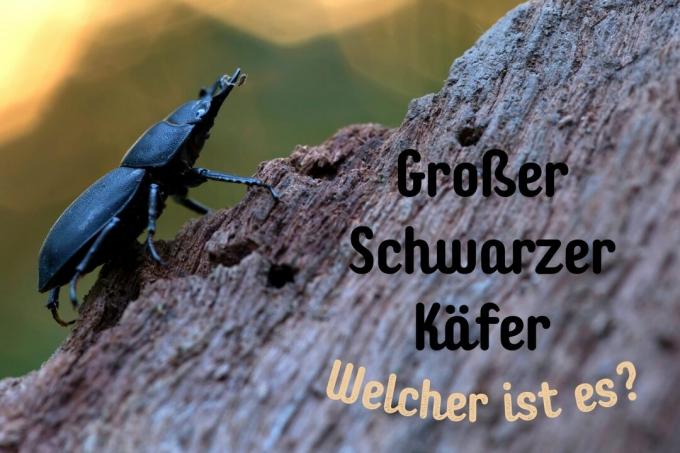
table of contents
- Scarab beetle (Scarabaeidae)
- Longhorn beetle (Cerambycidae)
- Kurzflügler (Staphylinidae)
- Ground beetle (Carabidae)
- Dung beetle (Geotrupidae)
- Click beetles (Elateridae)
- Schröter (Lucanidae)
- Black beetle (Tenebrionidae)
- frequently asked Questions
A black beetle often goes unnoticed by its color. The situation is different with large beetles. There are various species of black beetles in the house and garden that are not only useful.
In a nutshell
- among the longhorn beetles there are many black large species
- a black beetle in the house can be a sign of a pest infestation
- a large beetle is rare in nature, as they are easy prey
Scarab beetle (Scarabaeidae)
The scarab beetle family is very large and actually colorful. They include species such as the rose beetle or the genus of scarabs that are not native to this area. The scarab beetle family is divided into numerous subfamilies due to the diversity of species, including some larger species.
Hermit (Osmoderma eremita)

- Size: up to 38 mm
- Characteristics: black-brown, shiny, males with humps on the head, Hall shield with distinctive longitudinal bulges
- Occurrence: in the area of older trees with sludge
- Food beetles: pollen, nectar
- Food larvae: Mulm
Note: The hermit is also called the "Eastern Russian Beetle" and is a rare species. However, it became well known among the population through the “Stuttgart 21” railway project, because several trees that served as living space were removed for the construction.
Variable pear beetle (Gnorimus variabilis)

- Size: up to 23 mm
- Characteristics: shiny, wrinkled wing cover, wings occasionally with 4 - 5 light spots
- Occurrence: deciduous forests, parks with old trees
- Food beetles: pollen, nectar, tree sap
- Food larvae: Mulm
Longhorn beetle (Cerambycidae)
Longhorn beetles are common all over the world. A particularly large beetle of this type can be found in Brazil. There are around 200 native species in Europe, but they often cause problems. A black beetle in the area of the roof structure can be a sign of a pest infestation, because it is often the house buck.
House buck (Hylotrupes bajulus)
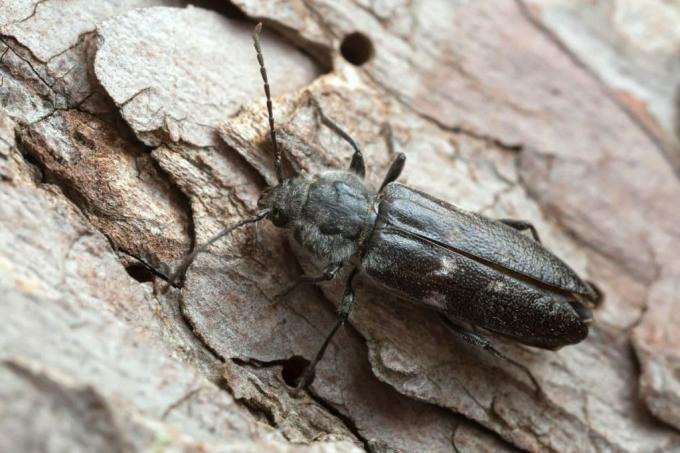
- Size: up to 24 mm
- Characteristics: slim shape, pronotum with two elevations, slightly hairy
- Occurrence: coniferous forests, roof trusses made of coniferous wood
- Food beetles: probably none
- Food larvae: dead coniferous wood
Lesser oak billy (Cerambyx scopolii)

- Size: up to 28 mm
- Characteristics: wrinkled wing-coverts, antennae in males exceeding body length, finely hairy
- Occurrence: deciduous forests, orchards
- Food beetles: pollen, nectar, tree sap
- Food larvae: wood from deciduous trees
Wood buck (Spondylis buprestoides)
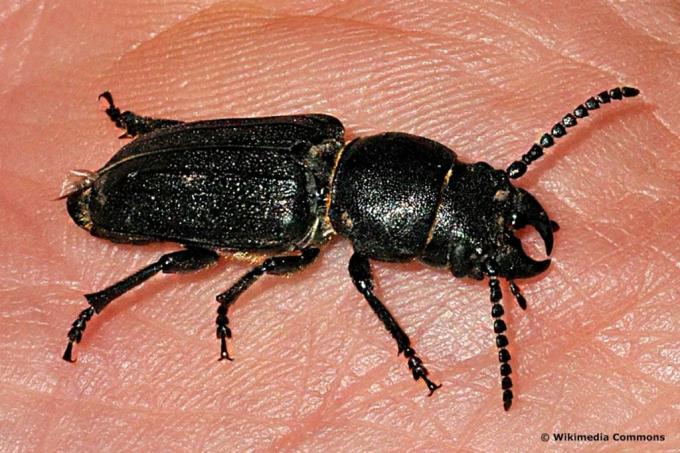
- Size: up to 24 mm
- Features: cylindrical build, pearl-like antennae, yellow hairline on the pronotum
- Occurrence: coniferous forests
- Food beetles: none
- Food larvae: wood of pine trees, Spruce, Fir, larch
Kurzflügler (Staphylinidae)
The Kurzflügler is characterized by the fact that they have only very short or stunted wings. As a result, they are usually unable to fly.
Hornet moth beetle (Velleius dilatatus)

- Size: up to 26 mm
- Characteristics: sawtooth-like antennae, wing-coverts occasionally also black-brown
- Occurrence: Hornets nests, Gardens, forests, orchards
- Food beetles: dead and living larvae of hornets and flies, occasionally tree sap
- Food larvae of hornets and flies
Ocypus ophthalmicus
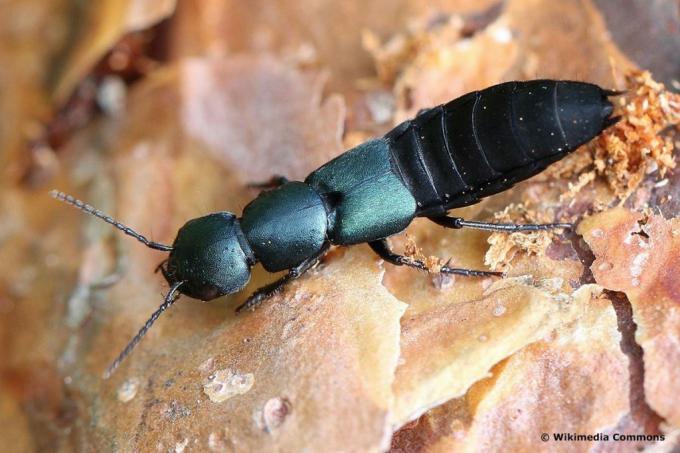
- Size: up to 23 mm
- Characteristics: pronotum and head finely dotted, articulated physique
- Occurrence: Forests, bushes, gardens
- Food beetles: worms, insects, snails
- Food larvae: worms, insects, snails
Ground beetle (Carabidae)
The ground beetle is no longer quite rightly named. Only a few species are actually flightless, but can still spread well. Due to recent genetic studies and the discovery of other species, however, there are flightable species within this family.
Large broad beetle (Abax parallelepipedus)
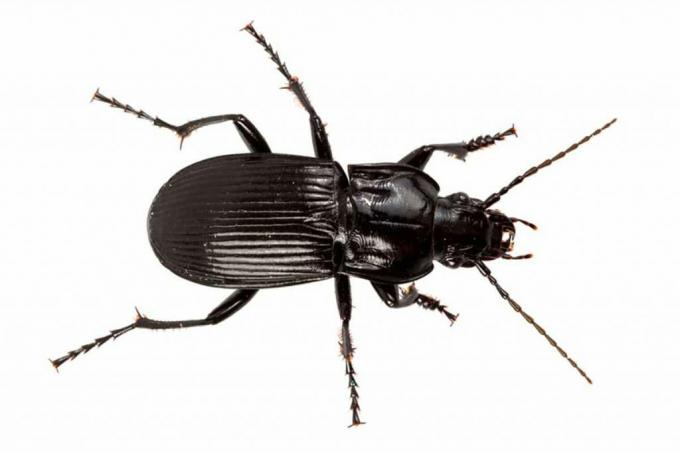
- Size: up to 21 mm
- Characteristics: bristles above the eyes, broad, shiny pronotum, pronotum with an elongated notch in the middle, elytra with longitudinal grooves
- Occurrence: forests
- Food insects, snails
- Food larvae: insects, smaller snails
Leather beetle (Carabus coriaceus)
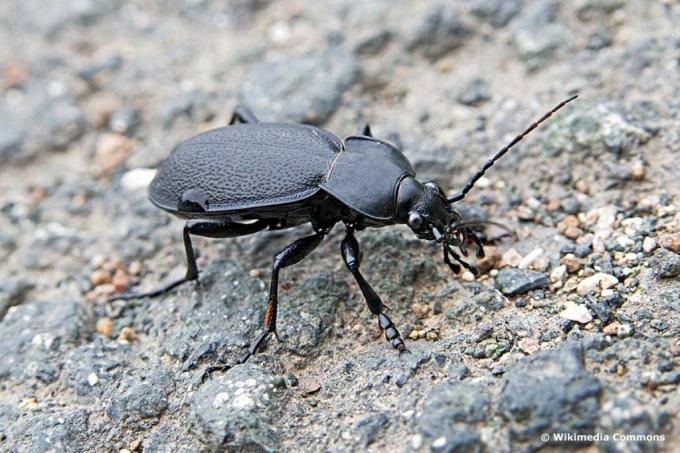
- Size: up to 40 mm
- Characteristics: dull, pronotum and wing-coverts wrinkled, which makes them look like leather
- Occurrence: Forests, bushes, natural gardens, moisture preferred
- Food insects, snails, worms
- Food larvae: insects, snails, worms, carrion
Dung beetle (Geotrupidae)
Dung beetles are widespread worldwide and are best known for their brood care. In some species, the larvae feed on dung that the beetles place in the breeding chambers. However, there are also subspecies that collect fresh leaves for their offspring and place them macerated in the brood cavity.
Bull beetle (Typhaeus typhoeus)

- Size: up to 25 mm
- Characteristics: shiny, males with three horns on the pronotum. Horns point forward
- Occurrence: sandy areas, heaths, pine forests
- Food beetles: droppings from rabbits, sheep, deer
- Food larvae: feces from rabbits, sheep, deer
Wood dung beetle (Anoplotrupes stercorosus)

- Size: up to 20 mm
- Characteristics: black-blue, shiny metallic, occasionally also brownish, violet or shiny green
- Occurrence: forests
- Food beetles: feces
- Food larvae: feces
Click beetles (Elateridae)
The click beetle is characterized by the ability to move quickly from a point with the help of a jumping device. You can even hear a kind of clicking noise, which is why the beetles are also called "click beetles" in English. In Europe, however, the population of species is declining as they often rely on wetlands for habitat.
Rose beetle (Selatosomus aeneus)
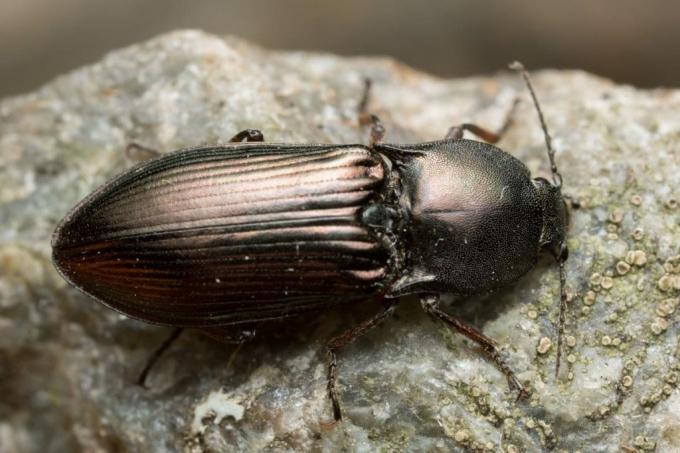
- Size: up to 16 mm
- Characteristics: shiny metallic, pronotum finely dotted, elytra with longitudinal grooves
- Occurrence: Meadows, fields, grasslands, low shrubbery
- Food beetles: flowers, leaves
- Food larvae: roots, occasionally insect larvae and small worms
Metal-colored bark snap beetle (Ctenicera pectinicornis)
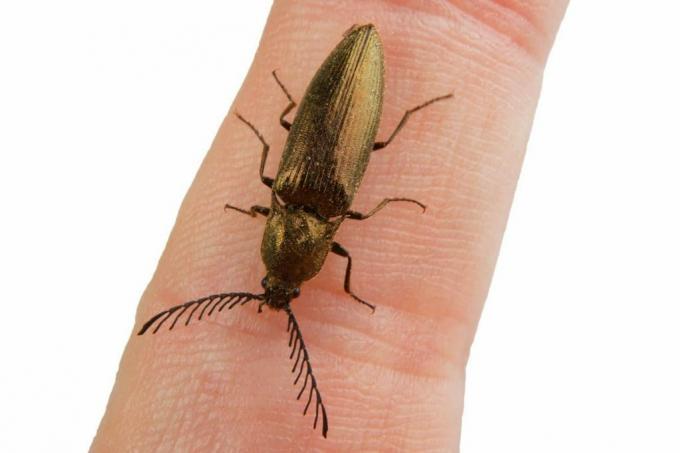
- Size: up to 18 mm
- Characteristics: shiny metallic, body converging to a point at the back, males with combed antennae, females rather with serrated antennae
- Occurrence: forest edges, bushes, wet meadows
- Food beetles: flowers, leaves
- Food larvae: plant roots
Schröter (Lucanidae)
The assignment of the Schröter family has not yet been clearly regulated. So far they still belong to the scarab beetle family, but they could be spun off as a separate family. There is a very well-known large black beetle in this family, but it has become increasingly rare in recent years. The stag beetle is the most famous representative in Europe.
Beam shredder (Dorcus parallelipipedus)
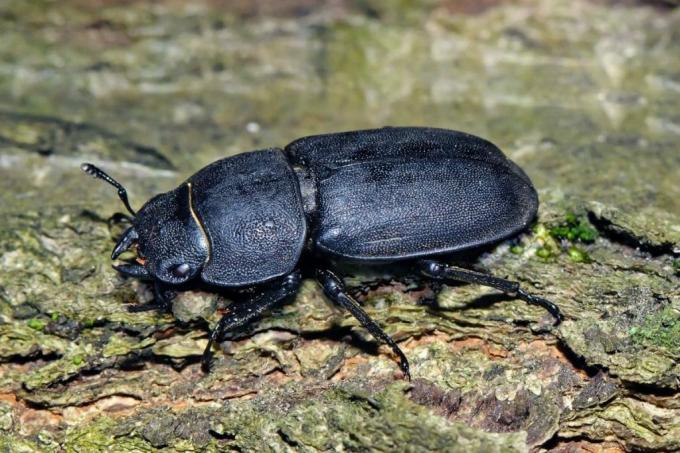
- Size: up to 30 mm
- Characteristics: shiny metallic, body converging to a point at the back, males with combed antennae, females rather with serrated antennae
- Occurrence: forest edges, bushes, wet meadows
- Food beetles: flowers, leaves
- Food larvae: plant roots
Stag beetle (Lucanus cervus)

- Size: up to 40 mm
- Characteristics: males with enlarged, antler-hard upper jaw, females with small upper jaw,
- Occurrence: forests
- Food beetles: tree sap
- Food larvae: fungal wood
Note: Although the stag beetle is a very large beetle, it is becoming increasingly rare as habitats are disappearing. The impressive beetle can mainly be found in original forests with large amounts of dead wood.
Black beetle (Tenebrionidae)
The name “black beetle” is often misleading, because the family does not only contain black beetle species. The group of black beetles includes many species that look very similar to other families and are therefore often difficult to identify. Within the family there is a large beetle, which is also considered a storage pest, the meal beetle.
Flour beetle (Tenebrio molitor)

- Size: up to 18 mm
- Characteristics: young animals rather reddish brown in color, wing with longitudinal grooves, reddish brown underneath
- Occurrence: culture followers, forests
- Food beetles: baked goods, flour, starchy plants
- Food larvae: starchy plant-based food, occasionally cannibalizing towards other conspecifics
Note: A black beetle of this species is also often brought into the house through decorative materials. Therefore, try to disinfect collected pieces of bark or branch pieces beforehand at a high temperature to prevent pests from spreading in the house.
frequently asked Questions
In addition to being a black beetle, the stag beetle is also the largest native species of beetle. In the total length from the "antlers" to the abdomen, it can be up to 9 cm long.
You can't tell from the outside whether a species is harmful. An indication that it is a pest is the way of life or the living environment. Pests can be found, for example, in the area of the building fabric or food.
Yes, variations in color are quite normal. A large black beetle that has a metallic sheen can also look different in light. Not all species are completely black. There are nuances of color within the species and occasionally female specimens have a slightly lighter color that turns brown.
In spring one can often see a large insect that many identify as a large beetle. However, this is not a beetle, but the blue-black wooden bee. However, a black beetle can also be observed in spring, the oil beetle. However, it is flightless and lives parasitically in wild bee nests. The oil beetle was previously suspected of infecting beehives, which has now turned out to be wrong.


